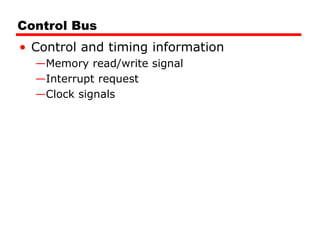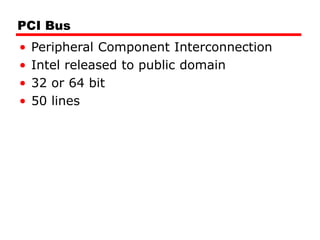03_Buses (1).ppt
- 1. William Stallings Computer Organization and Architecture Chapter 3 System Buses
- 2. Program Concept • Hardwired systems are inflexible • General purpose hardware can do different tasks, given correct control signals • Instead of re-wiring, supply a new set of control signals
- 3. What is a program? • A sequence of steps • For each step, an arithmetic or logical operation is done • For each operation, a different set of control signals is needed
- 4. Function of Control Unit • For each operation a unique code is provided —e.g. ADD, MOVE • A hardware segment accepts the code and issues the control signals • We have a computer!
- 5. Components • The Control Unit and the Arithmetic and Logic Unit constitute the Central Processing Unit • Data and instructions need to get into the system and results out —Input/output • Temporary storage of code and results is needed —Main memory
- 6. Computer Components: Top Level View
- 7. Instruction Cycle • Two steps: —Fetch —Execute
- 8. Fetch Cycle • Program Counter (PC) holds address of next instruction to fetch • Processor fetches instruction from memory location pointed to by PC • Increment PC —Unless told otherwise • Instruction loaded into Instruction Register (IR) • Processor interprets instruction and performs required actions
- 9. Execute Cycle • Processor-memory —data transfer between CPU and main memory • Processor I/O —Data transfer between CPU and I/O module • Data processing —Some arithmetic or logical operation on data • Control —Alteration of sequence of operations —e.g. jump • Combination of above
- 10. Example of Program Execution
- 11. Instruction Cycle State Diagram
- 12. Interrupts • Mechanism by which other modules (e.g. I/O) may interrupt normal sequence of processing • Program —e.g. overflow, division by zero • Timer —Generated by internal processor timer —Used in pre-emptive multi-tasking • I/O —from I/O controller • Hardware failure —e.g. memory parity error
- 14. Interrupt Cycle • Added to instruction cycle • Processor checks for interrupt —Indicated by an interrupt signal • If no interrupt, fetch next instruction • If interrupt pending: —Suspend execution of current program —Save context —Set PC to start address of interrupt handler routine —Process interrupt —Restore context and continue interrupted program
- 15. Transfer of Control via Interrupts
- 16. Instruction Cycle with Interrupts
- 17. Program Timing Short I/O Wait
- 18. Program Timing Long I/O Wait
- 19. Instruction Cycle (with Interrupts) - State Diagram
- 20. Multiple Interrupts • Disable interrupts —Processor will ignore further interrupts whilst processing one interrupt —Interrupts remain pending and are checked after first interrupt has been processed —Interrupts handled in sequence as they occur • Define priorities —Low priority interrupts can be interrupted by higher priority interrupts —When higher priority interrupt has been processed, processor returns to previous interrupt
- 21. Multiple Interrupts - Sequential
- 22. Multiple Interrupts – Nested
- 23. Time Sequence of Multiple Interrupts
- 24. Buses • There are a number of possible interconnection systems • Single and multiple BUS structures are most common • e.g. Control/Address/Data bus (PC) • e.g. Unibus (DEC-PDP)
- 25. What is a Bus? • A communication pathway connecting two or more devices • Usually broadcast • Often grouped —A number of channels in one bus —e.g. 32 bit data bus is 32 separate single bit channels • Power lines may not be shown • Data bus – bi directional • Address bus – uni directional • Control bus – bi directional
- 26. Data Bus • Carries data —Remember that there is no difference between “data” and “instruction” at this level • Width is a key determinant of performance —8, 16, 32, 64 bit
- 27. Address bus • Identify the source or destination of data • e.g. CPU needs to read an instruction (data) from a given location in memory • Bus width determines maximum memory capacity of system —e.g. 8080 has 16 bit address bus giving 64k address space
- 28. Control Bus • Control and timing information —Memory read/write signal —Interrupt request —Clock signals
- 30. Big and Yellow? • What do buses look like? —Parallel lines on circuit boards —Ribbon cables —Strip connectors on mother boards – e.g. PCI —Sets of wires
- 31. Physical Realization of Bus Architecture
- 32. Single Bus Problems • Lots of devices on one bus leads to: —Propagation delays – Long data paths mean that co-ordination of bus use can adversely affect performance – If aggregate data transfer approaches bus capacity • Most systems use multiple buses to overcome these problems
- 35. Bus Types • Dedicated —Separate data & address lines • Multiplexed —Shared lines —Address valid or data valid control line —Advantage - fewer lines —Disadvantages – More complex control – Ultimate performance
- 36. Bus Arbitration • More than one module controlling the bus • e.g. CPU and DMA controller • Only one module may control bus at one time • Arbitration may be centralised or distributed
- 37. PCI Bus • Peripheral Component Interconnection • Intel released to public domain • 32 or 64 bit • 50 lines




































